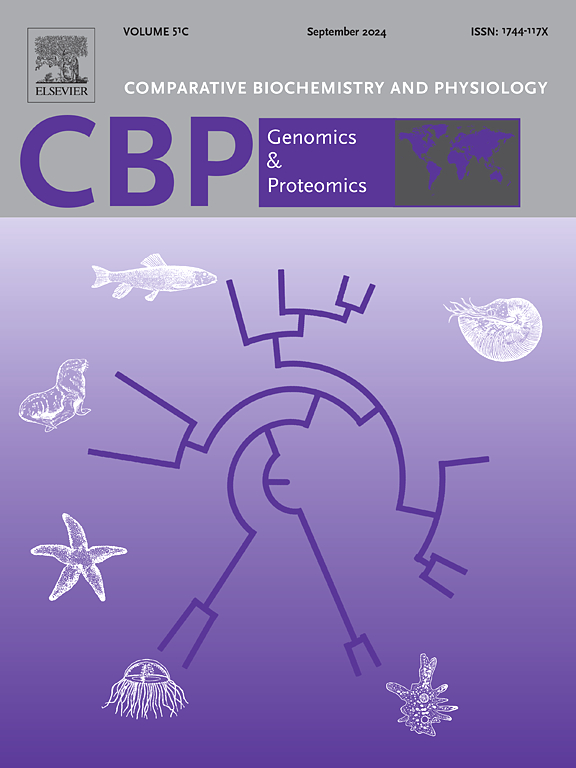肝脏和肠道转录组分析揭示了植酸酶驱动的杂交鲶鱼营养利用和代谢调节的分子机制
IF 2.2
2区 生物学
Q4 BIOCHEMISTRY & MOLECULAR BIOLOGY
Comparative Biochemistry and Physiology D-Genomics & Proteomics
Pub Date : 2025-05-20
DOI:10.1016/j.cbd.2025.101539
引用次数: 0
摘要
在水产饲料中使用植酸酶作为一种提高营养价值和减轻植酸不利影响的策略,特别是对于含有植物性成分的饲料,已引起越来越多的关注。尽管有植酸酶诱导表型改变的例子,但补充植酸酶的分子机制尚不清楚。本研究评估了植酸酶对Jubilee × D&;B杂交鲶鱼肝脏和肠道转录组谱以及生长、饲料系数(FCR)和血液学参数的影响。在140天的饲养试验中,与基础饲粮相比,添加植酸酶(2500单位/kg饲粮)显著提高了鱼的生长、FCR、红细胞计数、红细胞压积和血液总细胞计数。通过比较植酸酶补充鱼和对照鱼的转录组谱,我们确定了相对于对照的不同基因表达谱。该基因的特征是与矿物质代谢(包括铁)、能量稳态、蛋白质合成、碳水化合物和脂质代谢以及免疫反应相关的差异表达基因(DEGs)。讨论了关键deg的假定作用,包括它们在不同代谢途径中的相互作用。本研究从分子水平解释了添加植酸酶对杂交鲶鱼生产性能的益处,揭示了控制这些益处的转录组学机制,为水产养殖中定制功能饲料提供了有价值的信息。本文章由计算机程序翻译,如有差异,请以英文原文为准。

Liver and intestine transcriptome analysis reveals molecular mechanisms of phytase-driven nutrient utilization and metabolic regulation in hybrid catfish
The use of phytase in aquafeeds has gained increasing attention as a strategy to enhance nutritional value and mitigate the adverse effects of phytic acid, especially for diets containing plant-based ingredients. Notwithstanding examples of phytase-induced phenotypic changes, the molecular mechanisms underlying phytase supplementation are not well understood. The present study evaluated the effects of phytase on the transcriptomic profiles in the liver and intestine, as well as on growth, feed conversion ratio (FCR), and hematological parameters of Jubilee × D&B hybrid catfish. Over a 140-day feeding trial, phytase supplementation (2500 phytase units/kg diet) significantly improved growth, FCR, red blood cell count, hematocrit, and total cell count in the blood compared with fish fed the basal diet. By comparing the transcriptomic profiles of phytase-supplemented and control fish, we identified a distinct gene expression profile relative to controls. This profile was characterized by differentially expressed genes (DEGs) associated with mineral metabolism (including iron), energy homeostasis, protein synthesis, carbohydrate and lipid metabolism, and immune response. The putative roles of key DEGs, including their interactions in different metabolic pathways, are discussed. The current study explains the benefits of phytase supplementation on hybrid catfish performance on the molecular level, uncovers the transcriptomic mechanisms controlling these benefits, and provides valuable information for customized functional feeds in aquaculture.
求助全文
通过发布文献求助,成功后即可免费获取论文全文。
去求助
来源期刊
CiteScore
5.10
自引率
3.30%
发文量
69
审稿时长
33 days
期刊介绍:
Comparative Biochemistry & Physiology (CBP) publishes papers in comparative, environmental and evolutionary physiology.
Part D: Genomics and Proteomics (CBPD), focuses on “omics” approaches to physiology, including comparative and functional genomics, metagenomics, transcriptomics, proteomics, metabolomics, and lipidomics. Most studies employ “omics” and/or system biology to test specific hypotheses about molecular and biochemical mechanisms underlying physiological responses to the environment. We encourage papers that address fundamental questions in comparative physiology and biochemistry rather than studies with a focus that is purely technical, methodological or descriptive in nature.

 求助内容:
求助内容: 应助结果提醒方式:
应助结果提醒方式:


